Gene expression profiling reveals a diverse array of pathways inhibited by nuclear receptor SHP during adipogenesis
- PMID: 19079622
- PMCID: PMC2600469
Gene expression profiling reveals a diverse array of pathways inhibited by nuclear receptor SHP during adipogenesis
Abstract
Orphan receptor small heterodimer partner (SHP, NROB2) has been shown to be a metabolic regulator in pathways associated with several major aspects of the metabolic syndrome. However, the significance and transcriptional regulatory role of SHP in adipocyte differentiation remain unclear. Transcriptional profiles of 3T3-L1 preadipocytes and early differentiating preadipocytes in response to SHP were systemically surveyed using Affymetrix Genome Array representing well-characterized 14,000 genes. Analysis revealed about 963 genes that were up- or down-regulated by more than 2-fold during differentiation and/or by the overexpression of SHP. These genes were organized into 4 clusters that demonstrated concerted changes in expression of genes controlling various aspects of the cellular events and metabolism. Quantitative PCR was employed to further characterize gene expression and led to the identification of several key regulators and stimulators of the adipogenic program as potential new SHP targets. Overexpression of SHP inhibited the differentiation process as well as the accumulation of neutral lipids within the cells. Our data suggests that SHP may function as a molecular switch that governs adipogenesis and a potent adipogenic suppressor that maintains preadipocytes in an undifferentiated state through inhibition of the adipogenic transcription factors and stimulators. Developing SHP agonist may promise a future treatment for obesity.
Keywords: SHP; adipocyte differentiation; gene expression profiling; microarray; nuclear receptor.
Figures





Similar articles
-
SHP-2 positively regulates adipogenic differentiation in 3T3-L1 cells.Int J Mol Med. 2007 Jun;19(6):895-900. Int J Mol Med. 2007. PMID: 17487421
-
Gene expression profile of adipocyte differentiation and its regulation by peroxisome proliferator-activated receptor-gamma agonists.Endocrinology. 2002 Jun;143(6):2106-18. doi: 10.1210/endo.143.6.8842. Endocrinology. 2002. PMID: 12021175
-
Inhibition of aromatase transcription via promoter II by short heterodimer partner in human preadipocytes.Mol Endocrinol. 2004 Jan;18(1):252-9. doi: 10.1210/me.2003-0211. Epub 2003 Oct 30. Mol Endocrinol. 2004. PMID: 14593077
-
Structure and function of the atypical orphan nuclear receptor small heterodimer partner.Int Rev Cytol. 2007;261:117-58. doi: 10.1016/S0074-7696(07)61003-1. Int Rev Cytol. 2007. PMID: 17560281 Review.
-
Targeting orphan nuclear receptor SHP in the treatment of metabolic diseases.Expert Opin Ther Targets. 2010 Apr;14(4):453-66. doi: 10.1517/14728221003652463. Expert Opin Ther Targets. 2010. PMID: 20230197 Review.
Cited by
-
Discovery of farnesoid X receptor and its role in bile acid metabolism.Mol Cell Endocrinol. 2022 May 15;548:111618. doi: 10.1016/j.mce.2022.111618. Epub 2022 Mar 11. Mol Cell Endocrinol. 2022. PMID: 35283218 Free PMC article. Review.
-
Transcriptional regulation of adipocyte formation by the liver receptor homologue 1 (Lrh1)-Small hetero-dimerization partner (Shp) network.Mol Metab. 2013 Mar 16;2(3):314-23. doi: 10.1016/j.molmet.2013.03.003. eCollection 2013. Mol Metab. 2013. PMID: 24049743 Free PMC article.
-
A pleiotropic role for the orphan nuclear receptor small heterodimer partner in lipid homeostasis and metabolic pathways.J Lipids. 2012;2012:304292. doi: 10.1155/2012/304292. Epub 2012 Apr 22. J Lipids. 2012. PMID: 22577560 Free PMC article.
-
An autoregulatory feedback loop between Mdm2 and SHP that fine tunes Mdm2 and SHP stability.FEBS Lett. 2012 Apr 24;586(8):1135-40. doi: 10.1016/j.febslet.2012.03.022. Epub 2012 Mar 23. FEBS Lett. 2012. PMID: 22575647 Free PMC article.
-
Transcriptomic analysis to elucidate the molecular mechanisms that underlie feed efficiency in meat-type chickens.Mol Genet Genomics. 2015 Oct;290(5):1673-82. doi: 10.1007/s00438-015-1025-7. Epub 2015 Mar 18. Mol Genet Genomics. 2015. PMID: 25782841
References
-
- Shoelson SE, Herrero L, Naaz A. Obesity , inflammation, and insulin resistance. Gastroenterology. 2007;132:2169–2180. - PubMed
-
- Badman MK, Flier JS. The adipocyte as an active participant in energy balance and metabolism. Gastroenterology. 2007;132:2103–2115. - PubMed
-
- Feve B. Adipogenesis: cellular and molecular aspects. Best Pract Res Clin Endocrinol Metab. 2005;19:483–499. - PubMed
-
- Holst D, Grimaldi PA. New factors in the regulation of adipose differentiation and metabolism. Curr Opin Lipidol. 2002;13:241–245. - PubMed
-
- Tontonoz P, Hu E, Spiegelman BM. Stimulation of adipogenesis in fibroblasts by PPAR gamma 2, a lipid-activated transcription factor. Cell. 1994;79:1147–1156. - PubMed
Grants and funding
LinkOut - more resources
Full Text Sources
